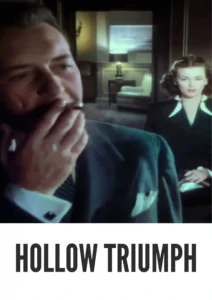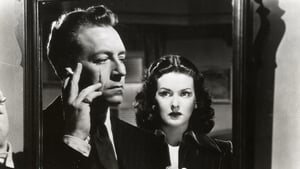Contact: [email protected]
Video Sources 0 Views
- Hollow Triumph


Synopsis
Table of Contents
ToggleReview: Hollow Triumph (1948) – A Dark and Intriguing Film Noir

Introduction
Hollow Triumph, released in 1948, is a gripping film noir that delves into the depths of human desperation and deceit. Directed by Steve Sekely, this classic noir masterpiece offers a dark and suspenseful narrative that keeps audiences on the edge of their seats. In this review, we’ll explore the shadowy world of Hollow Triumph and its enduring impact on the film noir genre.
Check The Full Colorized Movies List
Check Our Colorized Movies Trailer Channel
Understanding Hollow Triumph (1948): Director, Cast, and Genre
Directed by Steve Sekely, Hollow Triumph boasts a talented cast led by Paul Henreid and Joan Bennett. The film belongs to the film noir genre, known for its moody visuals, morally ambiguous characters, and atmospheric storytelling.
Exploring the World of Hollow Triumph (1948): Plot and Characters
Hollow Triumph follows the story of John Muller, a charismatic but troubled ex-convict who plans to pull off the perfect heist by impersonating a psychiatrist. However, his plan takes a dark turn when he becomes entangled in a web of deceit and betrayal. As Muller’s carefully crafted scheme unravels, he finds himself drawn deeper into a world of crime and corruption, where nothing is as it seems.
The Art of Film Colorization
While Hollow Triumph was originally filmed in black and white, its early colorized version adds a new layer of depth to its atmospheric visuals. The colorization process enhances the film’s moody atmosphere and captures the nuances of its shadowy characters with striking clarity.
Early Colored Films: A Brief History
The history of early colored films is marked by innovation and experimentation as filmmakers sought to enhance the visual appeal of their movies. From hand-tinted frames to pioneering technicolor processes, the evolution of colorization techniques transformed the cinematic landscape, offering audiences a new way to experience the darkness and intensity of film noir.
Hollow Triumph (1948) and Its Early Colored Version
The decision to release Hollow Triumph in a colorized format was made with the intention of immersing audiences in the film’s moody atmosphere and enhancing its visual impact. While some purists may prefer the original black and white version, the early colorized edition of Hollow Triumph adds a new layer of depth to its atmospheric cinematography and captures the psychological complexity of its characters with breathtaking clarity.
The Debate Over Film Colorization
The debate over film colorization continues to divide audiences and industry professionals alike. While some argue that colorization breathes new life into classic films and makes them more accessible to modern audiences, others maintain that it compromises the artistic integrity of the original work. As technology advances and filmmaking techniques evolve, the debate over colorization remains a topic of ongoing discussion within the film community.
Examining Hollow Triumph (1948) as an Early Colored Film
Viewing Hollow Triumph in its early colorized iteration offers audiences a fresh perspective on its moody visuals and atmospheric storytelling. The colorization process enhances the film’s dark and suspenseful atmosphere, drawing viewers deeper into its shadowy world of crime and deception. As audiences follow John Muller’s descent into darkness, they are treated to a visual experience that immerses them in the gritty realism of film noir.
Influence and Legacy: Hollow Triumph (1948)’s Impact on Cinema
Hollow Triumph is widely regarded as a classic of the film noir genre that continues to captivate audiences with its dark and suspenseful narrative. Its moody visuals, morally ambiguous characters, and atmospheric storytelling have left an indelible mark on cinema, influencing countless filmmakers and inspiring new generations of cinephiles.
Director’s Cinematic Legacy: Beyond Hollow Triumph (1948)
While Hollow Triumph remains one of Steve Sekely’s most acclaimed films, his directorial legacy extends far beyond this noir masterpiece. With a diverse body of work that includes thrillers, dramas, and war films, Sekely was known for his ability to craft compelling narratives that resonated with audiences on a deep and emotional level. Hollow Triumph stands as a testament to his talent and creativity, solidifying his reputation as one of the great auteurs of classic Hollywood cinema.
Themes Explored in Hollow Triumph (1948)
At its core, Hollow Triumph explores themes of identity, deception, and the consequences of our actions. Through its morally ambiguous characters and suspenseful storytelling, the film offers a nuanced portrayal of human nature, challenging viewers to confront their own beliefs about right and wrong as they navigate the murky waters of crime and corruption.
Reception and Controversy Surrounding Hollow Triumph (1948)
Upon its release, Hollow Triumph received widespread critical acclaim for its moody visuals, atmospheric storytelling, and standout performances. While the decision to release the film in a colorized format sparked debate among purists, its enduring popularity has cemented its status as a timeless classic of the film noir genre.
Where to Watch Hollow Triumph (1948) Online
For those eager to experience Hollow Triumph for themselves, the film is readily available on popular streaming platforms such as Amazon Prime Video, Google Play Movies, and iTunes. Whether viewed in its original black and white format or its early colorized iteration, Hollow Triumph offers a cinematic experience that is both dark and visually stunning.
FAQs About Hollow Triumph (1948)
1. Is Hollow Triumph based on a true story?
No, Hollow Triumph is a fictional film that explores the dark and suspenseful world of film noir through the eyes of its morally ambiguous characters. While the film’s storyline may draw inspiration from real-life events, its characters and plot are works of fiction.
2. Who starred in Hollow Triumph?
Hollow Triumph stars Paul Henreid in the role of John Muller, a charismatic but troubled ex-convict who becomes embroiled in a daring heist. He is supported by Joan Bennett, who delivers a memorable performance as his enigmatic accomplice.
3. What is the central message of Hollow Triumph?
At its core, Hollow Triumph explores the consequences of our actions and the lengths we will go to in pursuit of our desires. Through its morally ambiguous characters and suspenseful storytelling, the film offers a nuanced exploration of human nature, challenging viewers to confront their own beliefs about right and wrong as they navigate the murky waters of crime and corruption.
4. Why was Hollow Triumph released in a colorized format?
The decision to release Hollow Triumph in a colorized format was made with the intention of immersing audiences in the film’s moody atmosphere and enhancing its visual impact. While some purists may prefer the original black and white version, the early colorized edition of Hollow Triumph adds a new layer of depth to its atmospheric cinematography and captures the psychological complexity of its characters with breathtaking clarity.
5. What is the legacy of Hollow Triumph?
Hollow Triumph is widely regarded as a classic of the film noir genre that continues to captivate audiences with its dark and suspenseful narrative. Its moody visuals, morally ambiguous characters, and atmospheric storytelling have left an indelible mark on cinema, influencing countless filmmakers and inspiring new generations of cinephiles.
6. Are there any sequels or remakes of Hollow Triumph?
No, there have been no official sequels or remakes of Hollow Triumph. However, the film’s enduring popularity has inspired countless reinterpretations and homages in various media. Nonetheless, none have captured the dark and suspenseful atmosphere of the original 1948 classic.
7. Where can I watch Hollow Triumph online?
For those eager to experience Hollow Triumph for themselves, the film is readily available on popular streaming platforms such as Amazon Prime Video, Google Play Movies, and iTunes. Whether viewed in its original black and white format or its early colorized iteration, Hollow Triumph offers a cinematic experience that is both dark and visually stunning.
Conclusion
In conclusion, Hollow Triumph (1948) stands as a dark and suspenseful masterpiece of the film noir genre that continues to captivate audiences with its moody visuals, atmospheric storytelling, and standout performances. Whether viewed in its original black and white format or its early colorized iteration, Steve Sekely’s insightful direction and the stellar performances of the cast offer a cinematic experience that is both gripping and visually stunning. As viewers are drawn into the murky world of crime and deception, they are treated to a visceral journey that challenges their beliefs about right and wrong and leaves a lasting impact on their understanding of the human condition. Hollow Triumph remains a timeless classic that continues to enthrall and inspire audiences around the world.












